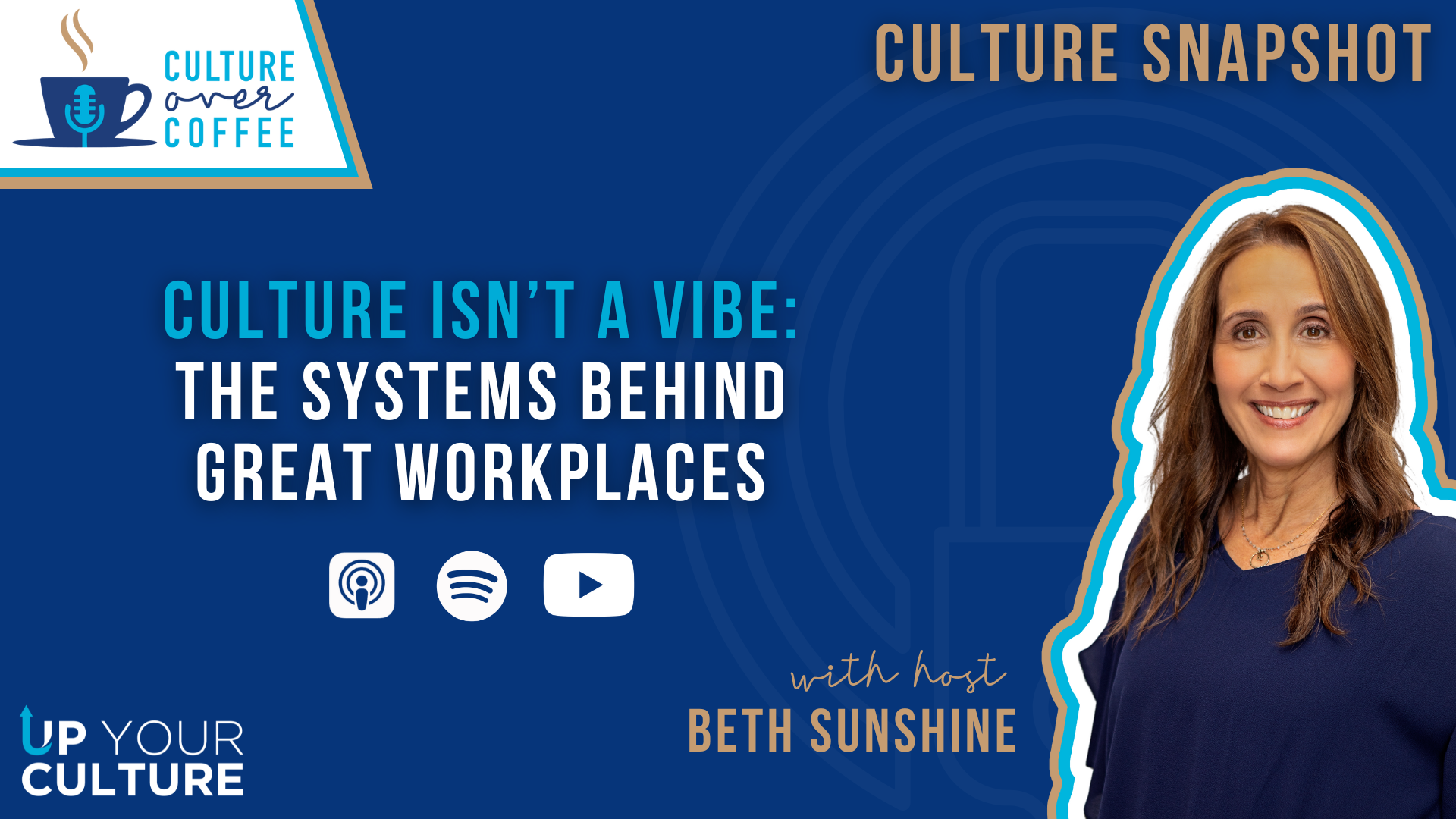.jpg)
In this episode, we’re continuing our focus on company leaders by taking a look at how to go about maintaining employee engagement when leading through times of adversity.
And we can’t think of a better leader to turn to for a topic like this than Lisa Kogan-Praska, CEO of the Boys & Girls Club of the Bay and Lakes Region.
Lisa has such amazing insights, like:
- How, without transparency, it’s hard to have an intentional culture
- Why, too often, leaders think they need to have all the answers, when, really, their job is to show the path forward
- And, finally, why, for leaders, being present WHEN you’re present can make a huge difference in the engagement of your teams
EPISODE HIGHLIGHTS
Defining the Ideal Culture:
When asked for 3 to 5 words that would describe an ideal company culture, Lisa offers:
- Intentional: “You can’t potluck your way to a great culture,” Lisa jokes. “It has to be more than that.”
- Transparent: Lisa says, “Without transparency, it's really difficult to have an intentional culture.”
- Dynamic: “The world has changed and so we can't think of our culture as static.”
The Role Leaders Play in Maintaining Engagement When Times Are Tough:
According to Lisa, leaders should avoid the misconception that they need to have all the answers. Instead, their role is to guide the way forward and build confidence in their teams.
Lisa says, “Our job is to show a path forward. We have to build confidence and connection together.
“We can find the answers, but it really is more of that coxswain position. We've got to get the team rowing.”
Leaders can also leverage change as an opportunity to rally their teams and create a collective vision for the future.
“There's also some just advantages to leading in a time of change,” Lisa says. “I came into an organization right as the world shut down. What was beautiful, as a leader coming into that situation, was I didn't turn the apple cart over. It was already turned over!
“There is some power when you're going through change that you can leverage. You can create that buy-in and say, ‘ok, let's talk about how to go forward.’
“So, being open to change and saying, ‘how can this actually be a strength and not just a deficit?’”
Lisa’s “Whiteboard Philosophy”:
Lisa shared her "whiteboard philosophy," which involved creating a space for employees to ask questions, voice concerns, and receive answers. This approach promotes transparency and open communication.
“Here's my thing,” Lisa says. “Write it on the whiteboard, and my promise is, I will answer the question. That applies to all staff, everyone, no matter what the question is.
There were some difficult questions, and at times they were like, ‘Oh, I don't really want to answer this in an all-staff setting,’ but it was so powerful.
“And what was so incredible about that is we started with some really tough questions, and by the end, people were like can, ‘We get different snacks?’
“I think it was because of that level of transparency. There is nothing that you can't ask. There's no topic that's off limits.
Connecting with and Supporting Remote/Hybrid Teams:
Remote and hybrid work setups should not hinder connection and support. Leaders can maintain strong relationships through various digital communication channels, Lisa says.
Lisa says, “I think sometimes we set the standard that ‘you're better connected when you're in the office’ and that can be true. But I have been guilty, many times, of coming to work, sitting in my office all day and not really seeing the people down the hall any more than if they had been remote.
“So, I don't know that communication is lacking just because we're not in the same location.”
“There's so many technologies now that allow you to have those same kind of [in-office] interactions. And I think we have to get out of that construct that a ‘face-to-face' has to be in the exact same location.
“A face-to-face can happen in a lot of different ways, and a quick little text to just say, you know, a silly thing or whatever is the same as walking by your office and saying, ‘How was your weekend?’
“So, we can do it. We just have to do it.”
Lisa also offered the idea of how holding virtual "office hours" can foster a sense of connection.
“I have a friend who held virtual office hours, and I thought that was fascinating.
“Her whole team was hybrid/remote, and she would just schedule office hours and be on doing her work, whatever it is, and if someone wanted to hop on, they could.
“There's absolutely no reason I couldn't have a zoom up while I'm doing my other work and then someone can knock virtually on my office door and say, ‘Hey, you got a second?’”
The Power of Recognition and Appreciation:
Lisa emphasizes that recognizing employees in a way that resonates with them individually is crucial. Tailoring recognition to each person's preferences ensures it feels authentic.
“At the end of the day, if you don't feel like you're valued, if you don't feel like you matter, if you don't feel like you're seen, it's impossible to feel engaged,” Lisa says. “So, I think that's huge.”
“That being said, I've always been a huge proponent of the platinum role in recognition and that means recognizing people the way that they want to be recognized. And that's why I think sometimes recognition programs fail. They become canned; they become structured.
Getting a gift card is great, but it's really about taking the time to say in the moment, ‘Wow, I see what you're doing, and thank you for showing up today and doing what you do.’
That's the key, and the rest is just icing on that cake, right? And then it just gets even sweeter after you do that.”
Common Pitfalls to Avoid During Times of Uncertainty:
Waiting too long to communicate during uncertain times can lead to employees creating their own narratives, often more negative than reality.
“Nobody wants to be the bearer of bad news,” Lisa says. “You know what I mean? And so, we want to wait... and then what happens is people create their own narrative if not given information.
“They will imagine all kinds of things are happening that aren't right. So, the more that you can, again, be transparent, [the better].
Lisa also suggests that culture should not be treated as optional during difficult periods. It is the foundation of engagement and should be prioritized.
“I know you have a strong sales background, Beth. You know, when times are tough, you don't cut back on your sales team, right?
“Culture is sales to our own employees. The last thing you want to do is pull back your sales force or your culture force in a time when it's more difficult.
“You want to ramp that up so that you can get out of that difficult time.”
The One Thing Leaders Should Start Doing:
Lisa's advice to leaders is to "be here now." Being fully present and actively listening to team members is the foundation of effective leadership.
“It's about being present in the moment,” Lisa says. “It's about listening, it's about asking questions. I'm going to intentionally walk around and talk to my team members or chat with them or do whatever that is. I'm going to make that connection.
“The rest of it can build, the strategies can build, but it really is about being present.
“When you're present, that will set the tone for everything else that you do.”


.png)








Leave a Comment